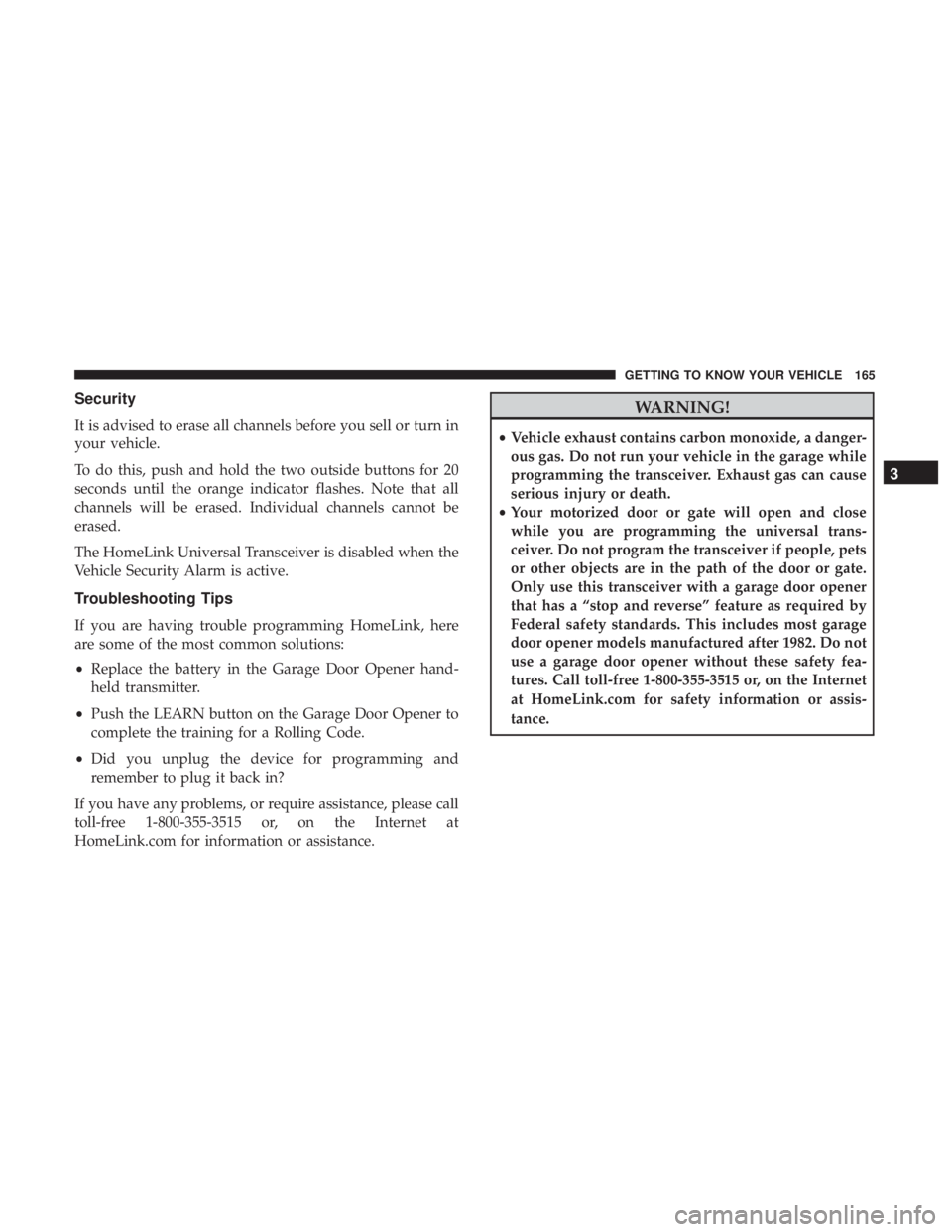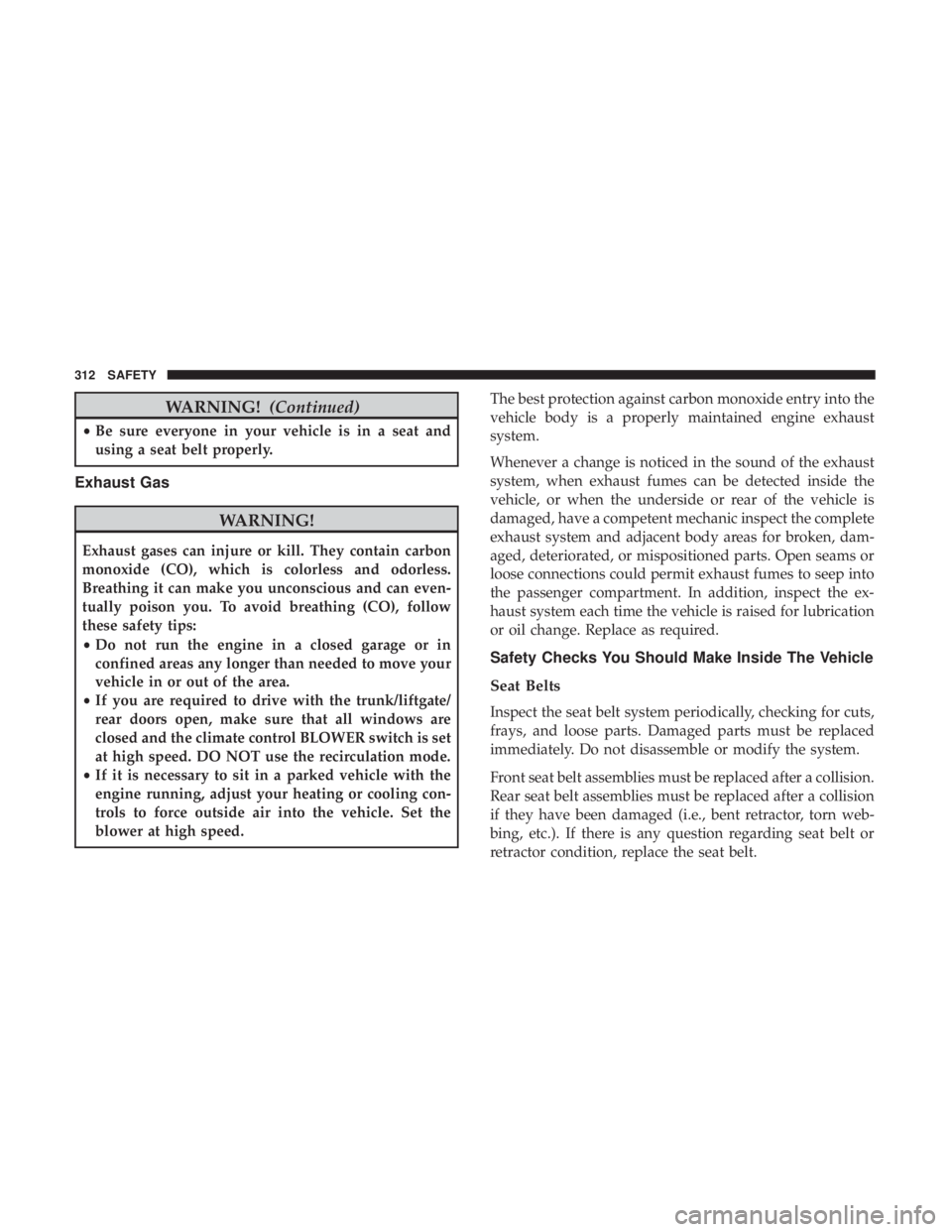2019 CHRYSLER PACIFICA Garage door
[x] Cancel search: Garage doorPage 167 of 718

Security
It is advised to erase all channels before you sell or turn in
your vehicle.
To do this, push and hold the two outside buttons for 20
seconds until the orange indicator flashes. Note that all
channels will be erased. Individual channels cannot be
erased.
The HomeLink Universal Transceiver is disabled when the
Vehicle Security Alarm is active.
Troubleshooting Tips
If you are having trouble programming HomeLink, here
are some of the most common solutions:
•Replace the battery in the Garage Door Opener hand-
held transmitter.
• Push the LEARN button on the Garage Door Opener to
complete the training for a Rolling Code.
• Did you unplug the device for programming and
remember to plug it back in?
If you have any problems, or require assistance, please call
toll-free 1-800-355-3515 or, on the Internet at
HomeLink.com for information or assistance.
WARNING!
• Vehicle exhaust contains carbon monoxide, a danger-
ous gas. Do not run your vehicle in the garage while
programming the transceiver. Exhaust gas can cause
serious injury or death.
• Your motorized door or gate will open and close
while you are programming the universal trans-
ceiver. Do not program the transceiver if people, pets
or other objects are in the path of the door or gate.
Only use this transceiver with a garage door opener
that has a “stop and reverse” feature as required by
Federal safety standards. This includes most garage
door opener models manufactured after 1982. Do not
use a garage door opener without these safety fea-
tures. Call toll-free 1-800-355-3515 or, on the Internet
at HomeLink.com for safety information or assis-
tance.
3
GETTING TO KNOW YOUR VEHICLE 165
Page 314 of 718

WARNING!(Continued)
•Be sure everyone in your vehicle is in a seat and
using a seat belt properly.
Exhaust Gas
WARNING!
Exhaust gases can injure or kill. They contain carbon
monoxide (CO), which is colorless and odorless.
Breathing it can make you unconscious and can even-
tually poison you. To avoid breathing (CO), follow
these safety tips:
• Do not run the engine in a closed garage or in
confined areas any longer than needed to move your
vehicle in or out of the area.
• If you are required to drive with the trunk/liftgate/
rear doors open, make sure that all windows are
closed and the climate control BLOWER switch is set
at high speed. DO NOT use the recirculation mode.
• If it is necessary to sit in a parked vehicle with the
engine running, adjust your heating or cooling con-
trols to force outside air into the vehicle. Set the
blower at high speed. The best protection against carbon monoxide entry into the
vehicle body is a properly maintained engine exhaust
system.
Whenever a change is noticed in the sound of the exhaust
system, when exhaust fumes can be detected inside the
vehicle, or when the underside or rear of the vehicle is
damaged, have a competent mechanic inspect the complete
exhaust system and adjacent body areas for broken, dam-
aged, deteriorated, or mispositioned parts. Open seams or
loose connections could permit exhaust fumes to seep into
the passenger compartment. In addition, inspect the ex-
haust system each time the vehicle is raised for lubrication
or oil change. Replace as required.
Safety Checks You Should Make Inside The Vehicle
Seat Belts
Inspect the seat belt system periodically, checking for cuts,
frays, and loose parts. Damaged parts must be replaced
immediately. Do not disassemble or modify the system.
Front seat belt assemblies must be replaced after a collision.
Rear seat belt assemblies must be replaced after a collision
if they have been damaged (i.e., bent retractor, torn web-
bing, etc.). If there is any question regarding seat belt or
retractor condition, replace the seat belt.
312 SAFETY
Page 551 of 718

Fuel Economy
Underinflated tires will increase tire rolling resistance
resulting in higher fuel consumption.
Tread Wear
Improper cold tire inflation pressures can cause abnormal
wear patterns and reduced tread life, resulting in the need
for earlier tire replacement.
Ride Comfort And Vehicle Stability
Proper tire inflation contributes to a comfortable ride.
Over-inflation produces a jarring and uncomfortable ride.
Tire Inflation Pressures
The proper cold tire inflation pressure is listed on the
driver’s side B-Pillar or rear edge of the driver’s side door.
At least once a month:
•Check and adjust tire pressure with a good quality
pocket-type pressure gauge. Do not make a visual
judgement when determining proper inflation. Tires
may look properly inflated even when they are under-
inflated.
• Inspect tires for signs of tire wear or visible damage.
CAUTION!
After inspecting or adjusting the tire pressure, always
reinstall the valve stem cap. This will prevent moisture
and dirt from entering the valve stem, which could
damage the valve stem.
Inflation pressures specified on the placard are always
“cold tire inflation pressure”. Cold tire inflation pressure is
defined as the tire pressure after the vehicle has not been
driven for at least three hours, or driven less than 1 mile
(1.6 km) after sitting for a minimum of three hours. The
cold tire inflation pressure must not exceed the maximum
inflation pressure molded into the tire sidewall.
Check tire pressures more often if subject to a wide range
of outdoor temperatures, as tire pressures vary with tem-
perature changes.
Tire pressures change by approximately 1 psi (7 kPa) per
12°F (7°C) of air temperature change. Keep this in mind
when checking tire pressure inside a garage, especially in
the Winter.
Example: If garage temperature = 68°F (20°C) and the
outside temperature = 32°F (0°C) then the cold tire inflation
8
SERVICING AND MAINTENANCE 549
Page 707 of 718

Fuel................................... .572
Additives ............................. .573
Clean Air ............................. .573
Ethanol .............................. .574
Filler Cap (Gas Cap) ..................... .422
Gasoline .............................. .572
Materials Added ........................ .573
Methanol ............................. .574
Octane Rating ....................... .572, 577
Requirements .......................... .572
Specifications .......................... .577
Tank Capacity .......................... .576
Fuses .................................. .456
Garage Door Opener (HomeLink) ...............160
Gas Cap (Fuel Filler Cap) .....................422
Gasoline, Clean Air ........................ .573
Gasoline, (Fuel) ........................... .572
Gasoline, Reformulated ..................... .573
Gear Ranges ............................. .336
Glass Cleaning ........................... .567
Gross Axle Weight Rating .....................426
Gross Vehicle Weight Rating ...................426
GVWR ................................. .424Hazard
Driving Through Flowing, Rising, Or Shallow Standing
Water ................................ .439
Hazard Warning Flashers .....................443
Headlights ................................97
Bulb Replacement ....................... .451
Cleaning .............................. .564
High Beam/Low Beam Select Switch ...........97
Lights On Reminder ....................97, 100
Passing ............................. .97, 99
Replacing ............................. .451
Switch .................................97
Time Delay ..............................97
Washers ................................99
Head Restraints ............................
85
Heated Mirrors ......................... .92, 95
Heater, Engine Block ....................... .327
Hill Start Assist ........................... .227
Hitches Trailer Towing .......................... .428
HomeLink (Garage Door Opener) ...............160
Hood Prop .............................. .145
Hood Release ............................ .145
Hook, Coat .............................. .173
12
INDEX 705
Page 715 of 718

Traction Control.......................... .221
Trailer Sway Control (TSC) ....................229
Trailer Towing ............................ .426
Cooling System Tips ..................... .437
Hitches ............................... .428
Minimum Requirements ....................432
Tips ................................. .436
Trailer And Tongue Weight ..................432
Wiring ............................... .435
Trailer Towing Guide ....................... .429
Trailer Weight ............................ .429
Transaxle Automatic ............................ .333
Operation ............................. .333
Transmission ............................. .335
Automatic ......................... .335, 536
Maintenance ........................... .536
Transporting Pets ...........................311
Tread Wear Indicators ...................... .552
Turn Signals ....................... .97, 215, 453
Uconnect Theater ............................... .641
Uconnect Settings ..................... .33, 586
Uconnect 4C/4C Nav With 8.4-Inch Display ........613Uconnect 4 With 7-Inch Display
................587
Uconnect Settings Customer Programmable Features ..........33, 586
Uconnect Voice Command ....................675
Umbrella Holder .......................... .169
Uniform Tire Quality Grades ..................561
Universal Garage Door Opener (HomeLink) ........160
Universal Transmitter ....................... .160
Unleaded Gasoline ........................ .572
Untwisting Procedure, Seat Belt ................253
USB................................... .640
Vacuum ................................ .152
Stow ‘n Vac ........................... .152
V
anity Mirrors .............................96
Vehicle Identification Number (VIN) .............570
Vehicle Loading ....................... .424, 545
Vehicle Modifications/Alterations .................5
Vehicle Storage ........................... .136
Vehicle User Guide In Vehicle Help ...........................18
Navigation ..............................18
Operating Instructions ......................18
Searching User Guide ......................18
Viscosity, Engine Oil ....................... .517
12
INDEX 713